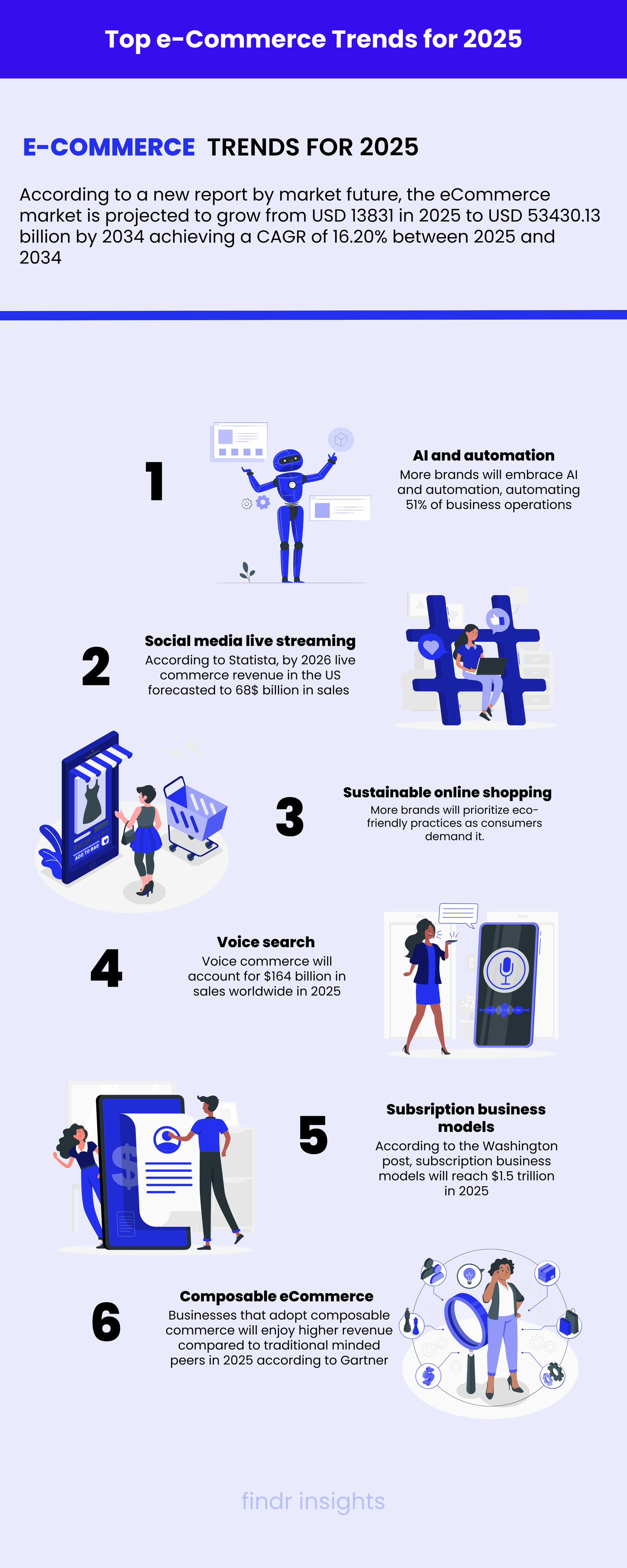
The e-commerce world is growing at an unbelievable pace. A new report by Market Research Future reveals that the eCommerce market is projected to grow from USD 13831.30 billion in 2025 to USD 53430.13 billion by 2034, achieving a compound growth rate of 16.20% between 2025 and 2034.
The rise of AI and automation, social commerce, and the growing demand for online shopping convenience are key factors fueling the rapid growth of eCommerce.
In this article, I’ll break down six major eCommerce trends in 2025 driving the industry’s rapid growth.
Table of Contents
1. AI and Automation Will Scale eCommerce Business
E-commerce’s rapid growth has forced businesses to look for new solutions to manage their business operations. This includes marketing, customer service, and order fulfillment.
AI has proven to be a great asset for businesses looking to increase productivity and save costs. For this reason, more businesses are beginning to adopt AI-powered automation in their workflows.
Now let’s look at some AI and automation trends in 2025 and how they will help businesses improve their operational efficiency.
AI-Powered App, Software & Website Development
Developing an eCommerce website, software, or app will no longer take months or thousands of dollars to set up.
AI tools like v0, Cursor, Bolt, Claude, ChatGPT, and Framer AI will generate fully functional, optimized websites in minutes, improving developer productivity and reducing the costs of code development by 45%, according to McKinsey.
AI-Generated UGC Ads and AI Influencers Will Dominate Marketing
Source: thedigiitals
In 2025, with tools like Arcads, Creator Kit, and Synthesia, brands can now produce high-quality content faster, cheaper, and at a larger scale.
AI avatars are taking over traditional content creation, eliminating the need for human creators and costly revisions.
Instead of spending hours revising content manually, marketers can focus on strategy and creativity while AI handles execution. This not only saves time and resources but also improves efficiency in content production.
With GenAI, brands can generate multiple content variations, enabling A/B testing and hyper-personalized campaigns tailored to specific audiences.
Although AI-generated UGC is still emerging, the technology is advancing rapidly.
Soon, AI-generated content will look just like human-made content, changing how content is created. At the same time, there’s a rising search interest for AI influencers on Google Trends.
Brands are beginning to realize they no longer need to spend millions on celebrity endorsements when AI influencers can deliver the same engagement, visibility, and sales—at a fraction of the cost.
Just look at companies like IKEA and McDonald’s, which are already leveraging AI-generated influencers to promote their products.
As AI advances, more brands will rely on AI-generated content and influencers. Businesses that don’t adapt to this trend might struggle to keep up, especially startups that need to scale their business without spending too much.
AI Task Automation Will Replace Manual Workflows
In 2025, AI task automation will take over repetitive workflows, eliminating the need for manual labor in many business processes. If you’re still handling tasks manually, you’re already behind.
Tools like Make, Zapier, Airtable, and UiPath are automating everything from customer support to inventory management, giving businesses a faster, cheaper, and more efficient way to operate.
Think about how much time you waste switching between apps, copying data, or manually processing orders.
Zapier automates app integrations, so you don’t have to move data manually. Make (formerly Integromat) builds complex automation workflows without writing a single line of code.
UiPath takes automation to the next level, using AI-powered bots to handle repetitive tasks across entire business operations.
According to McKinsey, 51% of all work tasks will be automated with today’s technology in the next ten years. AI-driven automation doesn’t just save time—it reduces human errors, lowers operational costs, and boosts productivity.
Instead of hiring large teams for data entry, order processing, or customer service, businesses are turning to AI to handle these tasks 24/7, with zero downtime.
If you’re not investing in AI automation now, you’re missing out on streamlining your business operations, cutting costs, and being ahead of your competition.
AI-Driven Order Fulfillment Will Speed Up Delivery
AI is transforming order fulfillment by making it faster, smarter, and more efficient. In 2025, many businesses will rely on supply chain innovations to speed up eCommerce operations.
So expect more brands integrating AI, automation, and drones to automate warehouse operations and optimize delivery routes.
AI-enabled demand forecasting will predict demand with greater accuracy, improving inventory management, which will help reduce understock and overstock situations.
Drones and autonomous delivery systems are finally taking off in major cities. In 2025, expect drone deliveries to become more common, especially in urban areas, providing fast delivery and reducing carbon emissions.
According to Prophecy Market Insights, the drone package delivery market is projected to skyrocket from $2.1 billion in 2024 to $38.5 billion by 2034.
At the same time, robotics and automation are transforming the order fulfillment process with autonomous guided vehicles (AGVs) and robotic arms to sort, pick, and package orders faster, reducing human error.
AI-Powered Customer Support Will Redefine User Experience
In 2025, AI-driven customer service will redefine user experience (UX) and customer experience (CX) across eCommerce platforms, making customer support faster, smarter, and more personalized.
According to Gartner, 47% of AI-mature companies rank customer service as one of the top three business functions benefiting from AI.
AI-based customer service tools provide major advantages, including:
- Instant responses, no hold times—customers get immediate answers instead of waiting for a human agent.
- Faster issue resolution—AI quickly handles common inquiries like returns, refunds, and shipping updates.
- 24/7 personalized recommendations – AI suggests products based on a customer’s past browsing and purchase history.
- Seamless omnichannel support—AI ensures customers get consistent assistance across chat, email, and voice.
By automating repetitive inquiries, AI can help human customer agents focus on complex issues, ensuring customers get the help they need at the right time.
This not only increases customer satisfaction but also helps brands increase conversion rates by resolving customer complaints faster, which can encourage them to repeat purchases with your brand.
2. Social media live shopping will become mainstream
Social media live shopping is set to become mainstream by 2025, completely disrupting how we shop online.
In countries like China, live shopping has already been around for over a decade now.
The Chinese live-streaming eCommerce sales hit $44 billion in 2025, with influencers and brands generating millions in sales through platforms like Taobao Live and Douyin.
In 2023, a Chinese creator made $14 million in sales in a week on Douyin live stream with an ultra-fast-paced product display.
This trend is catching on globally, with Western platforms like Instagram, TikTok Shop, and Whatnot increasingly integrating live shopping features.
However, only a few businesses are taking advantage of live-stream eCommerce. Gary Vaynerchuk, a public business figure, has been vocal about the potential of live shopping.
He reveals on one of his socials, Linkedln, that he had sold $150K worth of products in four hours on Whatnot during Black Friday sales, highlighting the power of live social shopping.
In five years, I believe you’ll walk down Main Street, and half of these store owners or their employees are going to be doing live shopping. They’re going to turn their stores into studios because the opportunity will be real. I believe retail in 2025 will become multichannel; it’ll be harder to survive just on brick-and-mortar. However, with the explosion of live shopping, you can have a first-mover advantage if you act now.
Gary Vaynerchuk
According to Statista, by 2026, live commerce revenue in the U.S. is forecast to hit $68 billion in sales, resulting in a 36% growth from 2023.
This growth will represent 5% of total U.S. online retail sales. Europe is anticipated to experience comparable progress, while Asia, despite leading the industry, still holds considerable unexplored opportunities for eCommerce businesses.
Businesses can take advantage of live social shopping in several ways.
You can host live product demos, flash sales, or Q&A sessions using platforms like TikTok Shop and Whatnot, which allow you to showcase your products in real-time and answer customer questions instantly.
And it doesn’t matter if you have a ton of followers or not. With TikTok, you can have zero followers, go live, and your live stream will grab the attention of random people on their For You page.
TikTok provides you the opportunity to build awareness for your brand at no cost.
Whether you’re looking to engage with customers, build stronger and more personal connections with them, or create a sense of urgency around your products, Whatnot and TikTok shops are great platforms you need to explore.
The immediacy and interaction in live shopping build trust and drive conversions, making it an effective strategy for businesses looking to increase their revenue in 2025.
3. Sustainable online shopping
Consumers are becoming more eco-conscious, and brands that fail to prioritize sustainability will lose customers.
IBM reports that 54% of consumers are willing to change their shopping habits to reduce environmental impact, and 44% reported that they consider sustainability greatly when choosing a brand when shopping.
In 2025, you’ll see more brands prioritizing eco-friendly practices because consumers demand it.
What Sustainable Online Shopping Looks Like in 2025:
According to NielsenIQ, 78% of global consumers say a sustainable lifestyle is important to them, and 30% are more likely to purchase products with sustainable credentials. This means brands that don’t adapt are likely to lose customers.
- Eco-friendly packaging—More brands will ditch plastic for biodegradable, recyclable, or reusable packaging to reduce waste. Expect more biodegradable and reusable packaging solutions.
- Carbon-neutral shipping—Companies like Amazon and Shopify are already investing in green logistics, using electric delivery vehicles and carbon offset programs. More brands will invest in carbon offsets and electric delivery fleets.
- Secondhand and refurbished goods—Platforms like ThredUp, Zara pre-owned, and Trove are gaining popularity because more consumers are choosing resale over fast fashion because it’s affordable, sustainable, and often just as good as new. Statista predicts the secondhand market will hit $350 billion by 2027.
- Ethical sourcing and production—Shoppers want transparency and ethically sourced products. Brands that use fair trade materials and sustainable supply chains will gain customer loyalty.
4. Voice Search Will Change How People Shop
Voice search is transforming how you find and buy products online.
With AI-powered assistants like Apple Intelligence, Android System Intelligence, and Amazon Alexa, voice searches are becoming more personalized, accurate, and conversational.
According to Voicebot, voice commerce will account for $164B in eCommerce sales worldwide in 2025, and over 50% of users already use voice assistants to search for products regularly.
If you’re not optimizing for voice search, you’re likely to miss out on potential customers and sales.
Voice search will be available everywhere as Apple’s new AI feature, Apple Intelligence, improves Siri’s capabilities.
Now, Siri’s voice and response will sound more natural, smarter, and conversational.
The Apple Intelligence will help Siri understand personal context, preferences, and shopping habits, allowing it to operate across multiple apps.
For customers who are shopping with voice search, Siri can compare products, suggest personalized recommendations, and even help complete purchases hands-free.
On the other hand, Android System Intelligence improves how Android devices predict user intent, making voice search smooth and more intuitive.
Whether you ask Google Assistant for product comparisons or request reorders, AI-driven assistants will anticipate your needs, reducing friction in online shopping.
For businesses, this means voice-optimized SEO is now essential. Consumers using voice search rely on conversational, long-tail search queries.
With over 50% of Internet queries coming from voice search, brands need to create content around natural speech patterns, optimize for featured snippets, and focus on local SEO to optimize for voice search.
At the same time, Alexa’s 2025 AI upgrade makes it easier to recognize and process complex voice commands.
So we can expect more shoppers to use Alexa to browse, compare prices, and order products hands-free.
Amazon reports that more than 75% of US households will own a smart speaker to use voice search for shopping in 2025.
5. The rise in subscription-based models
The subscription eCommerce business model is experiencing exponential growth as the demand for subscriptions has increased across industries, from fashion and beauty to food, SaaS, and digital content.
According to the Washington Post, this business model will reach $1.5 trillion in 2025 as more consumers demand convenience, personalized features, exclusive experiences, and cost savings.
This model ensures steady, predictable business revenue, reduces customer acquisition costs, and builds brand loyalty.
Brands like Amazon Subscribe & Save, Spotify, and Dollar Shave Club have proven that subscriptions improve customer retention and customer lifetime value.
About 70% of business leaders agree that subscriptions will contribute to the eCommerce industry’s continuous growth and expansion this year.
But with this growth comes a major challenge—churn rate. Keeping subscribers engaged and reducing cancellations is essential for the long-term success of subscription businesses.
6. Composable eCommerce Will be the future of scalable online stores
Composable eCommerce is changing how businesses build and scale online stores.
It offers them greater flexibility in creating their online stores, allowing them to mix and match commerce application tools—from payment getaways to content management sustainers and CRM solutions.
This flexibility lets business owners scale quickly without having to redesign their websites.
Why does this matter? Gartner predicts that businesses that have adopted composable commerce to stay competitive will enjoy higher revenue compared to traditional-minded peers in 2025.
With tools like BigCommerce, Commercetools, and Shopify Hydrogen, you can create a tech stack that meets your needs and scales as your business grows.
Composable eCommerce also improves performance. Faster load times, seamless third-party integrations, and AI-powered recommendations create a better shopping experience, increasing conversions and customer satisfaction.
With customer behavior and demands, and technological trends evolving rapidly, staying flexible and agile will be crucial for brands selling online in 2025.
If you want to stay ahead in 2025, it’s time to ditch outdated monolithic systems and embrace composable eCommerce solutions.
Conclusion
The e-commerce industry is set to experience unprecedented growth in 2025. Research shows that AI and automation will be the leading driving forces behind this growth, alongside social and voice commerce and sustainable shopping.
As consumer behavior and demand for eco-friendly solutions increase, brands will be pushed toward biodegradable packaging, carbon-neutral shipping, and ethical sourcing.
All in all, if you want to future-proof your eCommerce business in 2025, now is the time to embrace AI’s abilities and focus on the people who drive your business forward.
eCommerce Trends FAQs
1. What is the next big thing in eCommerce?
The next big thing in eCommerce is AI-driven automation, from personalized shopping experiences to AI-powered customer service, order fulfillment, and marketing. AI is the driving force behind eCommerce’s dynamic growth.
2. What are the trends in eCommerce 2025?
Some key eCommerce trends for 2025 include:
- AI and Automation – AI will dominate product recommendations, customer support, and marketing.
- AI-Generated UGC & Influencers – More brands will use AI to create realistic user-generated content and virtual influencers.
- Sustainable Shopping – More consumers will prioritize eco-friendly products and carbon-neutral shipping.
- Voice Commerce Growth – Voice assistants like Alexa and Apple Intelligence will make shopping more conversational.
- AI-Driven Order Fulfillment – Automated warehouses and smart logistics will speed up delivery times.
3. Will eCommerce continue to grow?
Yes, eCommerce will keep expanding. Global eCommerce sales are expected to surpass $7.9 trillion by 2027, driven by AI innovations, mobile shopping, and cross-border commerce. More businesses are adopting digital-first strategies, ensuring that online shopping remains a dominant force in retail.













